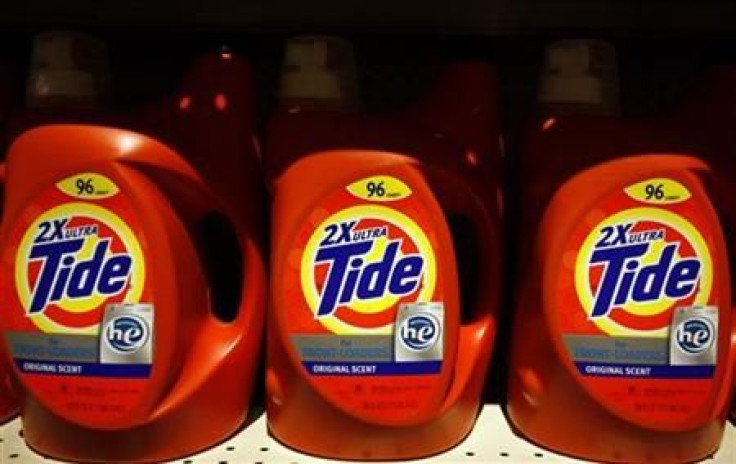P&G (PG) Q3 2014 Earnings Preview: Company Hopes New Razor Keeps Its Results On The Cutting Edge

It’s been said that if you build a better mousetrap the world will beat a path to your door, but what about razors and tooth whitener?
We’ll find out on Wednesday when Procter & Gamble Co. (NYSE:PG), the Cincinnati firm behind Pampers diapers and Tide detergent unveil results it hopes will vindicate a strategy narrowing its focus to a slew of new, premium products and trump a nasty winter that had consumers shut in across the nation.
The world’s largest consumer products company is expected to grow fiscal 2014 third-quarter net income 13.1 percent to $2.96 billion, or $1 per share, for the three-month period ended March 31, from 88 cents per share in the year-earlier period, according to analysts polled by Thomson Reuters.
Revenue is expected to rise 0.4 percent from $20.6 billion in last year’s third quarter to $20.68 billion in this fiscal year’s third quarter.
P&G has a core market in the U.S., but nearly two-third of sales and slightly more than half of its profits come from outside the U.S, according to a December company report.
Sales in developed markets like the U.S. and Japan made up 61 percent of total sales in 2013 and have fallen in recent years, while sales in developing markets like China, which together accounted for the remaining 39 percent of sales in 2013, have increased.
Foreign currency markets and weaker-than-anticipated market growth in P&G’s Beauty and Grooming segments pulled down profit in the company’s fiscal second quarter, October to December 2013.
The expected earnings growth could indicate P&G's strategy to boost productivity and sell noncore businesses successfully increased the company’s bottom line in recent months.
"Our vision is clear, and we are single-minded about our goals," CEO A.G. Lafley’s told investors and analysts gathered in February for the annual Consumer Analytics Group of New York meeting in Boca Raton, Fla. Lafley estimated that about 10 percent of the company’s brand portfolio is non-core.
P&G generates more than $80 billion in annual sales with top brands including Pampers, Tide, Always, Pantene, Bounty, Dawn, Charmin, Downy, Crest, Oral-B, Olay, Duracell and Gillette. P&G divides its brands into four business segments: beauty; baby, feminine and family care; fabric and home care; and health and grooming.
This quarter, unusually cold weather in much of the U.S. drove up commodity costs by as much as 48 percent for natural gas, according to BMO Markets, while inflation has continued rising in many emerging markets, including Indonesia, India, Turkey, Russia, Brazil and, particularly, Venezuela.
To counter the headwinds from a strong dollar and weak market growth in some segments, P&G’s focus in the third quarter was on rolling out new products in laundry, including Tide Plus upgrades and Tide Oxi, and new products in oral care, including Crest 3D White Brilliance, 3D White Luxe and 3D Whitestrips. The segments fabric and home care, which includes laundry products, and health care and grooming, which includes oral products, have grown sales more than other segments in recent quarters.
Last week, leaked marketing documents revealed P&G’s plans to introduce a high-end razor for men with a swiveling ball-hinge that pivots the blade. The ProGlide FlexBall is the first major upgrade from Gillette since 2010, when the five-blade Fusion model was updated with new blade technology. The razor will hit the market June 9, in time for Father’s Day, and is expected to generate $188 million in sales for the first year. Company spokeswoman Kara Buckley said the company will share more details about the razor at a launch event April 29 in New York.
The recent launches of premium products mark Lafley’s return in strategy to squeeze more revenue from the upscale market while risking an exodus of more frugal customers. McDonald had reigned in the company’s premium product strategy from 2010 to 2012 after it hurt sales during the recession and its aftermath.
The other part of Lafley’s strategy, selling non-core businesses, continued in the third quarter. In February, he announced that P&G will divest what remains of its global bleach business, including brands in Latin America, Eastern Europe, the Middle East and Africa.
Then, P&G announced April 9 that it sold about 80 percent of its noncore pet care business to Mars for $2.9 billion. The pet food brands, including Iams, Eukanuba and Natura, have struggled in recent quarters.
“Strategically, we believe this transaction makes sense for P&G, as it helps the company increase its focus on its core brands in more attractive areas such as beauty care, fabric care, health care and grooming,” Joseph Altobello, an Oppenheimer analyst, wrote in a research note this month.
Analysts expect P&G’s businesses Duracell batteries and Braun small appliances are next in line for sale, and that the second half of 2014 will reap the most earnings growth from the product launches.
© Copyright IBTimes 2024. All rights reserved.












